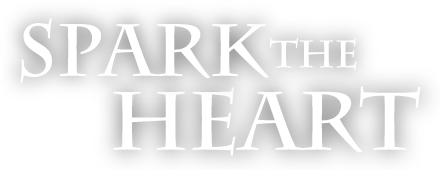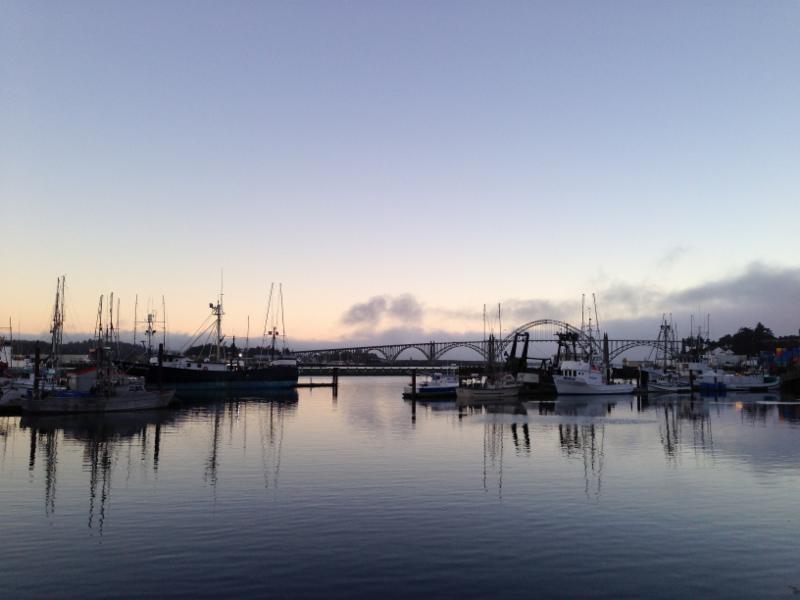Sand and Trees and Sky
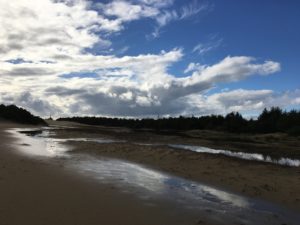
As you may know, I am in the process of closing my Mac training business after 30 years of helping people love their Macs. I’m doing it for all of the right reasons and it feels good. I’m excited about whatever is next, and I know this is what I really want for myself.
Yet, this in-between time niggles me.
I used to spend a lot of my working time gathering content and publishing the weekly Mac Tips and sharing the Mac love on Facebook. Now, without that busy work, I twiddle my thumbs and wonder what I’m supposed to be doing with this time.
One day last week I even considered continuing to send out the weekly tips, because folks really do enjoy them. I thought about charging for the yearly subscription to make it worth my time. And then I caught myself. This is not where I want to grow my energy. This is no longer the relationship that fulfills me and shines a radiant, glowing future. I need to stick to the plan of phasing things out, so that I am open and available for what is next.
It’s like when you leave any relationship. The habit to call or text or connect is still fresh. You start to rationalize why you may want to stay together. You think, well, maybe it wasn’t so bad. Because without it, there’s a lot of uncomfortable open, empty space.
But this is where the light shines in. This is where new sparks and old dreams raise their voices and call you forward.
And so, on that day that I started to fall backwards into what I know, what’s comfortable even though it’s not what I really want, I asked myself, what new thing I could do instead, that would take me away from the computer screen.
It was 45° outside, but not raining, and I knew the best thing would be to move in my body. I put on my winter layers and grabbed my litter-picker-upper stick and bucket and a pair of rubber gloves to go over my regular ones nd headed out. It felt so good to breathe in the crispy air. My shoes left imprints in the frosted grass as I walked up to Lighthouse Road and scanned for trash. There were no snack wrappers or beer cans, just cigarette butts in the parking area.
Two county workers were buzz-sawing the bushes behind the whale watching platform, creating a wider viewing area for tourists. I worried that they had removed the cross I had seen tucked back there the other day. But the area had actually been cleared, the vase of navy blue silk flowers was now standing next to the cross, and I could read the carved word, Dad.
I walked back toward the Meditation Triangle Park, intending to sit and enjoy the view. The water was so calm, the sky was the bluest blue, full of fat white clouds. I spotted a piece of trash a few feet down the trail to the dunes. I hadn’t walked that trail yet, deterred by its steepness, but today I said yes.
After I plucked the paper, I realized I didn’t want to have to climb back up the trail with a full bucket, so I left it at the trailhead. It was also there in case something happened and Marika needed to find me.
The trail started out as dirt but soon I was walking in sand, soft, like powder, but packed from all of the rain, so it was like walking down steps. Steep steps that cut a three foot wide path between tree roots and pine tree branches, wheat-colored grasses and blackberry bramble. After about three hundred yards of stair-stepping down, the trail opened up to the crest of the dunes and it looked like it ended with a hundred foot drop.

I took some pictures, then walked to the edge and looked down, and there were the dunes, stretching north and south as far as I could see, the pond-sized puddles in the valley of the sand, the ridge of trees, the ocean beyond that, and the wide-open sky.
I walked down the steep slope of the sand and, when I looked back, I spotted the motor home and the lighthouse, tucked behind the trees. I took pictures in every direction to capture the enormity of the sand and the sky.
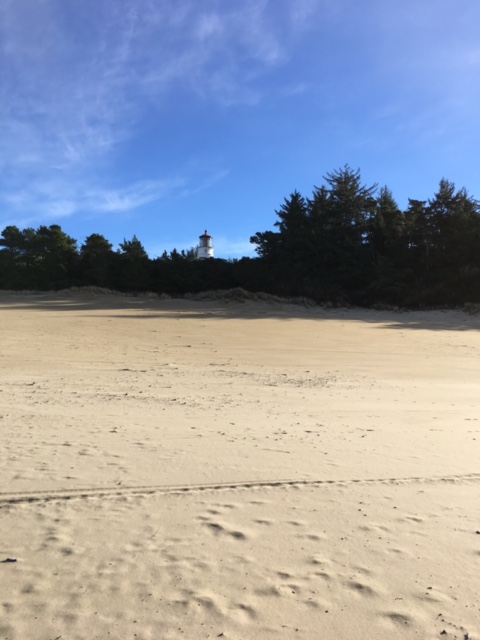
I walked across a flat section of sand, then down to the twenty-foot wide puddles. There were snack wrappers and plastic bottles, hair ties and broken glass, and I regretted not having my litter bucket with me. I heard the rumble of a faraway ATV, the steady moan of the foghorn and the rustle of my nylon coat sleeve as I walked. Birds chitted in the trees and the Coast Guard helicopter flew overhead. I couldn’t see the ocean, only sky and trees and sand, rising and sloping in all directions.
I turned toward the sun and planted me feet in the sand, finding my alignment, dropping my weight and my breath into the sand. I did some modified sun salutations, then folding down into a good, long, down dog. It took a few minutes to find a position where my hands didn’t shift in the sand. And I breathed into my body, my bones, my heart.
The climb back up the dunes was hard work. I felt the muscles in the tops of my thighs and my buttocks. I stopped several times to feel my pulse, catch my breath, and take in the view. And I was so aware that, with each step, I was saying yes to this next wave of goodness, of me bringing more of myself and my gifts to the world. I may not yet know what that looks like, but standing there, my heart pounding and the horizon oh, so wide, I knew that I was ready.
Breaking Eggs
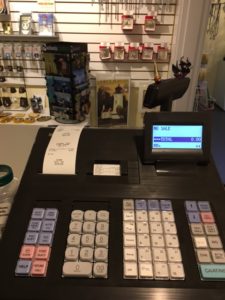
Our new volunteer job at the Umpqua River Lighthouse includes giving tours AND selling tickets to the museum, which means using a cash register and making change. My first real job, scooping ice cream, included ringing up sales on a cash register. And in college I was the assistant manager of a recycled clothing store where I learned how to run a credit card through the machine to generate three carbon copies, cash out the register drawer, run daily reports and fill out reconciliation sheets. So working the cash register at the Lighthouse didn’t scare me, though I knew I’d have to learn a new system, a new sequence of buttons, and how to use a chip-reading credit card machine.
Marika, on the other hand, has never worked a cash register, never made change, and is not tech-savvy. But even though she was terrified of the job, she wanted to try a new thing.
The day before our first official shift, we hung out with our co-hosts, Jackie and Ray, to learn the ropes of closing the museum. We had read the notes but wanted to get some hands-on experience.
Jackie walked us through the three floors of the museum, telling us which lights get turned off, which doors stay open, where to store the signs from outside, which curtains got hung on which windows, and how to clear the answering machine. She showed us which key opens the desk drawer to get the key for the register, and then she showed us how to close out the register.
Jackie pushed each button on the register as I wrote down the steps. Marika hovered over her shoulder trying to follow along, even though she couldn’t see the buttons or read the screen on the credit card machine to know what to select.
After the third step, I asked if it was written down somewhere. Jackie pulled out a typed paper from the drawer. “Why? Do you want to read along while I’m doing it to see if I’m saying it right?” No,” I said, “I just didn’t want to write it all down if it was already written someplace.”
From that moment on, I think she felt challenged by me. Maybe because she spent her working career in banking, something very exact, accurate, linear. She was conveying information, but not necessarily teaching us.
When we got home that afternoon Marika was feeling very anxious about the whole thing. I reminded her that everything was written down. I assured her that I’d help her with the register, that we’d go over it step by step with her pushing the buttons, and that, if she didn’t feel comfortable with the whole money thing, she didn’t have to do it. I also told her how proud I was that she was even trying.
“But what if I can’t remember it all?”
“No one expects you to,” I said. “It’s only our first day.”
“I just don’t know if I can do it. How am I going to remember everything?”
I took her hand and said, “What if this were a bakery job. They wouldn’t expect you to make a fifteen layer wedding cake on your first day, would they?”
“No,” she said. “They’d probably have me breaking eggs.”
“OK,” I said, “so tomorrow is all about breaking eggs.”
And that calmed her. She went back to memorizing the Lighthouse facts, rewriting dates on her note cards, rehearsing the script out loud.
The next morning we got to the museum early to open. We turned on all of the lights, took down the curtains, put out the open signs, opened the register, and counted the cash together. Marika announced that I would ring up all the sales for the day and we would lead the tours together.
Thankfully, it’s not the busy season, so I could take my time to find the correct buttons on the register. I had no problems with the credit card sales and was feeling very confident about closing out the register.
At the end of the day we ran the reports together, counted the money together, and it was my job to transfer the numbers to the reconciliation sheet. It took three tries to get all of the numbers in the correct places and have everything balance. But we did it. Together.
And then we were told that, from now on, we’d be running the gift shop as well as selling tour tickets, which meant we couldn’t do the tours together since one of had to stay in the gift shop. Marika freaked again because now there were more buttons to use on the register. And so we decided that I would do the register and she would lead the tours.
On our first do-everything day, I settled into my stool behind the counter, ready for customers while Marika took a couple on a tour. I checked my email, then walked around the store, familiarizing myself with the inventory. I straightened the books on the shelves, rearranged some items to make them more visually appealing, refolded t-shirts and zipped up jackets. And I had no trouble ringing up sales. Marika enjoyed her tour groups, even though all of those lighthouse steps made her knees achy. We closed out the register together and the next day, Marika even rang up a few sales.
Yes, I miss doing the tours, being outside and sharing the magic of the light. But I’m enjoying the engagement with folks as they browse the gift shop, and it fills my heart that we are doing a job that involves a cash register. Because this opens us up to more opportunities for future volunteer gigs. Last month I was willing to clean yurts and now she is learning how to run a register. Together, we can do anything!
The Joys of Litter Picking
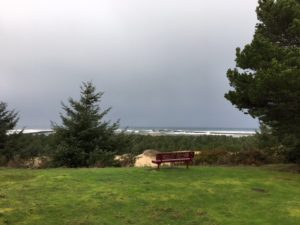
Last week I shared how much I enjoyed the litter picking part of our job, because we were outside, walking trails, and driving in the golf cart, singing and making a game of it.
I had even said to Marika, “I want a litter picker upper for Chanukah.” Because everywhere we went, I honed in on all of the litter that needed to be picked up, and I never had a bag with me. Marika, the ever money-conscious part of this team said, “New raingear, new shoes, the radiator and the dehumidifier?” You already got your presents.”
And I let it go, realizing I could simply carry a plastic bag and wear rubber gloves.
And then, during our first shift at the Lighthouse Museum, Marika found a litter picker in the hall closet, next to the cleaning supplies. It was even nicer than the one I used at the campground, with two rubber circles at the ends of the grabbers for better pick up accuracy. I took it home, along with a plastic yellow bucket and a handful of latex gloves, and this morning, I went litter picking.
It was in the low 40’s but I was warm with my three layers of sweatshirt, hoody and rain jacket, and my latex gloves over my winter gloves. They sky was gray, the waves were white and it wasn’t raining.
I started around our camping spot, picking up the empty Irish Springs soap boxes that the previous camper left, maybe for keeping mice away. Then I walked up the grassy hill and plucked small pieces of papers from the bushes along the edge of the Douglas County Maintenance parking lot.
I turned onto Lighthouse Road, and walked around the curve to what I call the Triangle Meditation Park, a large, grassy area on the bluff above the Oregon Dunes and the ocean. It is surrounded by sala plants, rhododendron bushes, and three kinds of shrubs and trees.
There is a red metal park bench at the edge of the bluff, offering a 180° view of the ocean. If you sit on the right edge of the bench, you are in exact alignment with the top of the Isosceles triangle that is formed by the south jetty and the training jetty, where the Umpqua River meets the Pacific Ocean. There’s an oyster farm in the triangle, said to be the best because the oysters are suspended in the water, never touching the sandy bottoms, and they filter a perfect mix of 80% salt water and 20% fresh water from the river.
The bench was wet, so I just stood and looked out at the waves crashing hard and high over the jetties. It started to sprinkle, so I pulled my rain jacket hood over my head and kept going.
I walked the rim of the park area, scanning the grass and foliage for anything that wasn’t green. I found soggy white tissues and brown, fast-food napkins. I was fooled by a curled up bright orange leaf, thinking it was a Cheetos bag. I plucked silver can tabs, a few bottle caps, and three 25 oz cans of Hurricane High Gravity malt liquor that were tucked deep in the brambling blackberry vines. I was grateful for the length of the picker, and the wide mouth on the end of the grabbers.
Back in the wayside parking lot where cars pull in for the view, I picked up at least a hundred cigarette butts. Most were smoked down to the last inch and a half, in varying stages of disintegration. With the outside papers gone, the soggy white filters stuck to the ground, and they were the hardest to grab. After picking them up one at a time, I tried two, then three, then how many could I get at once.
Picking up and dropping them into the bucket had a meditative rhythm, but, doing it right handed, my shoulder started to hurt. It’s never been the same since I slid, unexpectedly, out of the tow truck on my return from the Heart Sparks Road Tour last year. It was a long first step down and I yanked my shoulder as I slid until my feet touched the ground.
And this picker stick must be longer than the one I used at the State Park, because I’m moving my arm differently in order to drop the trash in the bucket. When I switched to using my left hand, I noticed I was pulling my arm back, as if I were shooting an arrow. I tried it with my right side and it didn’t hurt as much.
When I put the bucket down and just worked the same area, it was even better. I switched off, left handed, then right again, filling my yellow bucket with the torn off pieces of wrappers, an empty cigarette pack and a two-inch spring, which I pocketed to add to my found art supplies.
I saw a candy wrapper behind the whale watching station so I walked in the dirt along the railing and found an empty can of sliced mushrooms in front of two white crosses with blue bows on them. I took the can, said a prayer, and went back up to the parking lot for more cigarette butts.
On the walk back I did a visual sweep of the street and saw my lost index card with my lighthouse notes on the road, nearly disintegrated from being run over in the rain. The blue markered words WATCH ROOM were barely readable at the top of the card. I picked up what I could and headed toward home.
I stopped again at the triangle bench and the sky has turned a darker gray out over the water. The horizon line was barely visible and the waves were still crashing high on the jetty. The sprinkling had turned to a faster shower and I realized my feet were pretty cold. Still, I stood on the bluff and watched the waves roll for a few more minutes. I did a series of modified sun salutations, even though there was no sun, soaking in the gifts of this place, this life, and saying thank you.
Update From Umpqua
It’s hard to believe that we’ve been on the road, living this life, for seven months. Each experience seems to open us up just a little more, to who we are, what we love, and how we can serve.
We really loved our time working at the Cape Blanco Lighthouse last month, meeting people from all over the world, sharing the specialness of the oldest continuously operating lighthouse on the Oregon coast. And we realized how much we enjoy having a schedule, being of service, and staying in one place for a month to settle in, spread out, explore the area.
This month our volunteering has us cleaning yurts at the Umpqua River Lighthouse Campground in Reedsport, Oregon. The deluxe yurts are octagons, twenty four feet in diameter, with wooden floors and thick, vinyl fabric that has been stretched over an exposed wooden frame to create a sturdy, weatherproof shelter. Each yurt has two queen futon sofa beds and a three-person bunk bed, built-in shelves, and a coffee table. There is a kitchenette with a fridge and microwave, a large bathroom with a shower, DVD player, skylight, ceiling fan, an outdoor grill, and a covered deck. They rent for $80.00 a night and guests provide their own linens, toiletries, food, and coffee machine.

While Lighthouse Hosting required more energy connecting with people and sharing information, yurt cleaning work is more physical – sweeping, mopping, wiping down surfaces. And we are enjoying it. The biggest perk of the job is that I get to drive a golf cart from our campsite to the yurts. This may not seem like a big deal, but driving a golf cart has been on my bucket list for years! And so, every morning, it is sheer delight to show up for work and tool around in our electric cart.
We pick up our schedule in the office to find out which two or three of the six deluxe yurts we’ll be cleaning that day. Then we drive down to the yurt village to get our supplies from the chase, the cleaning closet that holds our brooms, mops, rags, trash bags, and bottles of spray cleaners. We load up our cart and, as soon as a yurt key is turned in, we are ready to clean.
After we unload our supplies onto the deck, I go inside, turn on the lights, turn down the thermostat, check the fridge temperature and open the skylight. Then I head outside to sweep the deck and the door mat, clean the BBQ if it was used, and remove any spiders and cobwebs around the outside of the yurt. Meanwhile Marika is inside spraying disinfectant on every surface that a person might have touched.
When she has moved into the bathroom, I put on a surgical mask to minimize breathing in the chemicals, and start wiping down everything she has sprayed. I use the yellow string mop on the vinyl covered futon mattresses and a rag on everything else. I use the fuzzy brush on an extended pole to wipe any cobwebs on the inside walls and ceilings, and put new plastic bags in the trash cans. I close the skylight, sweep the floor, put the key in the lock box for the next guest, then wait out on the deck while Marika washes the floor behind me. It takes forty five minutes to an hour, at a slow, easy pace. And then we take a break.
This pace is very different from running a business. I am learning that I don’t have to rush, or multi-task; that part of the four-hour workday includes chatting with the other hosts, checking my email, taking a break on the yurt deck to enjoy the view of Lake Marie.

After our yurt cleaning, we do litter-pick up and bathroom restocking, either at the day use area, or in the campground. I like that activity too, because we walk around. We each take a plastic gallon bucket and a litter-picker-upper grabber and go in opposite directions.
At the day use, Marika checks the picnic tables and fire pits in the grassy area near the bathrooms, and I take the path to the trail around Lake Marie. I don’t do the full mile loop, just the section with picnic tables, and where people fish along the shoreline. I scan for trash along the sandy beach and under the shrubbery. Sometimes I find fishing filament, balled up and stuck on a branch. Sometimes there are cigarette butts and empty snack bags. But mostly, it is clean and litter-free.
Yesterday a kayaker was in the lake and asked if I was a volunteer. Yes, indeed, I said. He thanked me, and then said he had found a bobber to throw away, so he paddled to the shore and I walked into the water because I had my rubber boots on, and he dropped it in my bucket.
“There’s some trash down along there,” he said, pointing just a few yards down the bank. “I can show you.” I hiked back up to the path and he guided me to a prime fishing spot. He pointed with his wooden paddle. “Over there, just under that branch.” I plucked a white paper bag and a very brown banana peel and thanked him for his help.
When I get back to the golf cart, I tell Marika the story and how fun it would be to get out the kayak and do our own lake shore cleanup, but she is not ready to commit. We drive to the dumpster with our trash, then return the golf cart to the garage and walk across the parking lot to home.
Our campsite is not in the campground with the other hosts. Instead, we are up the road with the Park Rangers’ office and shop, next to the hosts only laundry room. I love the quiet and privacy. We have lots of dog romping room, and green grass on the other side of the black top that leads to the office. We can see some open sky, but mostly we are surrounded by a forest of thick-trunked evergreens standing more than a hundred feet tall. After the rangers leave for the day, we have the place completely to ourselves.
Just down the main road, past the day use area and around the corner, is the ocean, the Umpqua River, Winchester Bay, a whale watching wayside, and the Umpqua River Lighthouse.
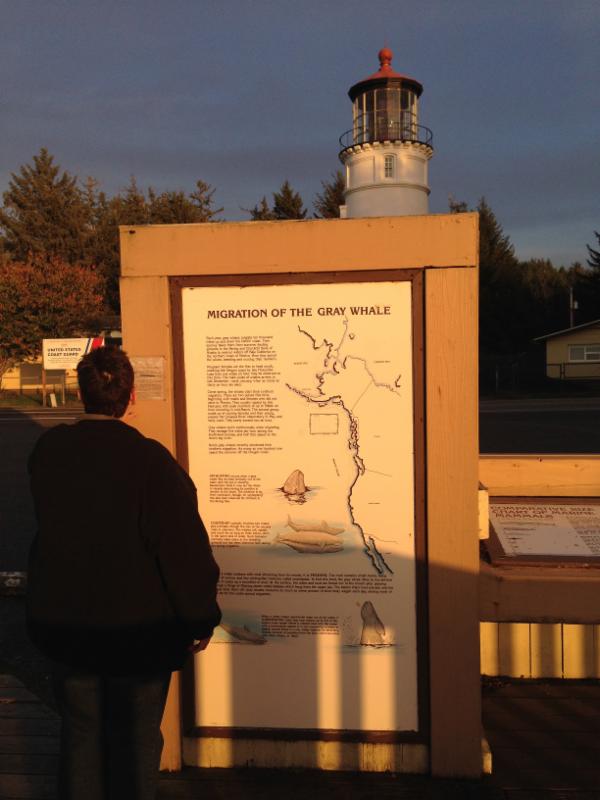
Last Saturday, after a yurt cleaning shift, we drove down to the Lighthouse, hoping to take a tour. The official tour season ended in October, but the gift shop is still open and there is a sign promoting weekend tours.
The woman in the gift shop explained that she needed more than two people to give a tour. We shared that we had been hosts at Cape Blanco and were hoping to see how this lighthouse compared. Next thing you know, she was asking if we wanted to be Lighthouse Tour hosts in December, because she was finally leaving the job after working there for the last seven months, seven days a week.
We had been planning to head south to the Salton Sea in southern California after yurt cleaning, where the weather is drier and warmer, and where there are thousands of migrating birds. But this was an opportunity to share a lighthouse that might close for the season if they didn’t get volunteers. So we took the application and told her we’d think about it.
On the drive home we talked about the pros and cons. It is very wet on the Oregon Coast in the winter, and December is probably going to be even rainier. Nothing dries in the RV, and the dog towels stink. And there are very few birds for Marika to enjoy. But it’s a lighthouse! And we’d be learning new stuff, meeting fun people, and keeping the Lighthouse alive for another month.
And, as wet as it is, I much prefer this weather to the parched desert. I love being able to take a walk in the rain now that I have waterproof shoes, a waterproof jacket and rain pants. And the 55° days are, surprisingly, not too cold for Marika. Her knees are bothering her more in the dampness, but she said that wasn’t enough of a reason to say no.
The next day we looked at the campsite we’d be in, level and grassy, overlooking the Oregon National Dunes, with a spectacular 180° view of the ocean, the river and soon, whales, on a clear day. It’s also a prime winter storm watching spot, another thing that’s been on my bucket list since our first visit here 19 years ago. And, in addition to the usual full hookups of electricity, water and sewage, we’d also have cable TV and wifi, which are a big deal for us. I was ready to say yes, but Marika was still 50/50. She just didn’t like constantly feeling damp.
We stopped into the local RV parts store looking for a new kind of sewage chemical. The owner was a native and we asked her about the rain in December. She said, just get a de-humidifier and a radiant heater, and it’ll keep everything dry inside, and comfortable.
We had three beautiful days of clear, dry skies, and even some sun, and everything dried out. We took the dogs down to the beach below the lighthouse for a leash-free romp along the south jetty. We enjoyed a campfire in the middle of the afternoon, another first for me. And we researched de-humidifiers and radiant heaters.
When I asked Marika when she’d be deciding, she said, “Well, if we’re buying all of this wet weather equipment and waterproof clothing, we might as well use them longer.” She also announced that she was finally going to order the outdoor propane fire pit that she’s been eyeing for months.
The next day we went over to the Lighthouse to sign our volunteer papers and get our tour scripts to start learning. We met our future co-hosts, an older couple who thought they were just going to be caretakers over the winter, but were eager to take on giving tours as well. They had just started the day before, had already memorized most of the script, and were happy to give us a tour.
The Umpqua River Lighthouse is gorgeous. The Fresnel lens inside is one of only two in the world that you can actually climb into. And its signature light is white and red. At night, the light dances around the circle of trees in amoeba-like shapes and it is absolute mesmerizing. We can’t wait to share the beauty with visitors.
We’ll be here at the State Park cleaning yurts through the end of November, then we move to our new spot around the corner on Douglas County property December 1 to begin our month of Lighthouse hosting.
We still plan to head south to the Salton Sea in January for some sun and birds and kayaking. We’re not sure how long we’ll be there, but we’re expecting to spend the month of March in Phoenix. That’s as much as I know for now. And that feels pretty OK.
Because without fretting about the far future, I’m able to really embrace where we are, right here, right now. My lungs feel expansive, my skin stays moist without body lotion, and I love walking in the forest. It’s like a fairyland of lush and green, glistening with raindrops and mushrooms that are bigger than my hand. The trails are covered with thick layers of soggy leaves and pine needles, and all around there are fallen trees, some more than a foot in diameter, carpeted in soft, iridescent moss. I’ve learned to drape my rain jacket over them when I need a dry place to sit.

We finally put the RV awning down, the first time since we’ve been on the road, and Marika arranged our chairs around the new propane fire pit. We sat there as the rain started falling, grinning and dry, happy-grateful for it all.
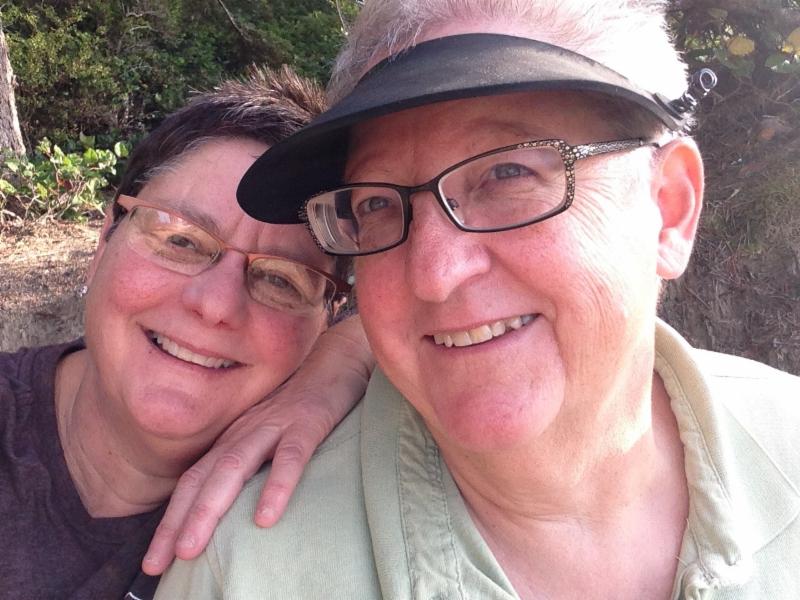
A Lighthouse Story
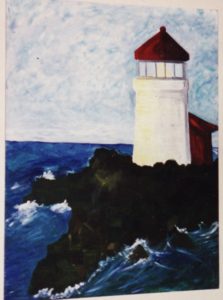
(Note: I wrote this six years ago, in September, 2010. Seeing the life I have created since then, I know it’s because I committed to a plan.)
I was never one for having a long-term plan. When people asked “what are your goals for 5 years, 10 years?” I’d look at them blankly. I had no idea.
I would tell myself, I live in the moment, I can’t possibly know what I’ll be doing in 10 years.
And yet, in the deep of my heart, I DID have a vision of what I wanted to be doing, where I wanted to be living. I just never shared it.
Not even with myself.
Because some voice inside of me said that, if I wasn’t doing it NOW, then I must be a failure.
I only knew how to have short term goals. I didn’t know how to create a long term plan.
And so I tucked my secret dreams deep and away and continued to believe that the only long term goal I needed was to just be happy doing whatever I was doing.
And then, a few months ago, I went to New Jersey and spent a week at the beach in Cape May. I was so happy in the ocean air, watching the waves and the gulls, eating fresh seafood right off the boats. My heart felt so full.
And I realized how much I had been denying that this is what I want for my future. That I DO want something more than just being happy in the present moment.
When I got back home I knew I was ready to untuck my dreams of living on the Central California Coast and start to make a plan.
And it occurred to me that, this is exactly what a five-year plan is all about.
It’s NOT about doing it NOW.
A plan is about knowing where you are and where you want to be and using the time in between to discover how to get from here to there.
My big first step was realizing that I DID have a dream.
My second big step was reclaiming the dream and bringing it into my daily awareness.
Several years ago I had put all of my lighthouse paintings into the back of my closet so that I wouldn’t be reminded of the ocean. But now I was eager to hang them prominently all over my house. They no longer taunted me with longing, but now served as a beautiful visual reminder of where I am going to be living.
My third big step was sharing my dream. I started telling my friends, “I’m on a five-year plan to live at the beach.”
By naming and claiming it, suddenly there is noticeable movement toward this thing I most desire.
In fact, now that my mom has passed away, I’ve adjusted the time frame and now I’m on the two-year plan to live at the beach.
It feels possible. It feels real. And I KNOW it’s going to happen.
I don’t know all the things that I have to do between now and moving to make this happen, but I know that, if I stay focused and clear, each step will be revealed in time.
Because I’m planning for it. I’m committed. And I’m doing it, one step at a time.
NOTE: Yes, I did “move” to California in 2012, but not as I had originally imagined. I lived in my 24′ motorhome across the street from the beach for 6 months out of the year until December 2015.
Now, my partner Marika and I are living full-time in a bigger motorhome, and this month we are realizing a huge, long-time dream: we are giving tours of a working lighthouse on the Oregon Coast.
Looks a little bit like my painting, dont’cha think???

So what is YOUR dream for yourself one year from now, five years from now, ten years from now?
1. Do you hold that dream in your consciousness?
2. Do you imagine what it will be like, feel like, taste like to be living this dream?
3. Do you share you dream with people, give voice to your vision?
3. Have you considered what you need to do today to make it happen in that time frame?
4. Do you have your one next step clearly defined?
I’d love to help you explore these questions. If you’d like to set up a coaching call, or dive into to a 4-week Heart Sparks coaching immersion, email me.
The Joy of the Kayak!
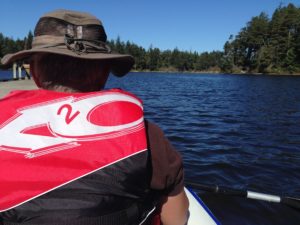
After years of dreaming about it, I finally bought an inflatable kayak. It came with two deluxe seats, two paddles, a carrying case and a repair kit, big enough for two for when Marika wants to join me. We inflated the kayak on the asphalt next to the RV to try it out. It was easy to inflate and comfortable to get into. But it had a small tear in the skirt of the bow (front of the boat).
I called the manufacturer and they said they would send a replacement skirt. Meanwhile, I was anxious to try the kayak out, even without the skirt fully inflated. So we folded it into a manageable 2’x5’ bundle, and hoisted it across the backseat of the RAV4.
I chose to take my maiden voyage in a small lake at a city park, instead of the river or slough where I’d have to deal with the tides. And this way, Marika could walk the trails and look for birds, while I was on the water. I cried on the drive over, just so full of joy and readiness. We parked near the official boat launch beach and inflated the kayak near the car, then carried it thirty feet down to the lake. I got in, she gave me a good push, and I was on the water.
I paddled toward the middle of the lake, gulls frolicking in the water beside me, Marika, waving to me from the shore. I felt stable, relaxed, and my stroke was light, yet strong. I practiced stopping and circling, paddling slow and fast. And then I lifted my paddles out of the water to feel the slight current in the water move me oh, so slowly, into the center of the lake. Coils of underwater plants, thick as a bottlebrush, but soft and floaty, surrounded my boat. The air was still and quiet beyond the noise of the gulls, and I heard myself thinking, “I am in my very own kayak in the middle of a lake on the coast of Oregon!”
I paddled around a tree island, out of Marika’s view, and watched three men fishing off of a twenty foot wooden pier. I turned toward the opposite shore and paddled to within ten feet of the bank and I floated, scanning the shoreline for movement.
A great blue heron stood as still as the driftwood next to it, and I almost didn’t see it. We watched each other for a good long time, neither one of us moving. Then it spread its wings, lifted up, skrawking as it flew to an upper bough on a nearby tree.
I moved along too, toward a couple in matching orange kayaks near the center of the lake. “Nice day to be on the water,” he said. “Yes it is!” I said. “It’s my first time in my new boat and I’m loving it!” The woman took one hand off her paddle and gave me a thumbs up. “You’re gonna love it!”
I made one more long pass to the opposite shore, then headed toward the put-in beach where Marika was sitting on a bench, talking on her phone. I fast-paddled up the incline and onto the wet sand and the boat skidded to a stop. I leaned back against my seat, grinning, and handed her my paddle. “That was amazing!”
I went out again two days later, to the bigger lake in the park. There were tall green trees and coves and tree islands, and gulls and an egret and a man fishing from a rubber boat. I paddled to the furthest shore and around a line of dead tree snags jutting from the water. I enjoyed the paddle, but not the solitude. And so Marika said that the next time, she would join me.
We went to the bigger lake and she paddled solo first. I was glad she was able to get into the kayak easily, and she felt comfortable on the inflatable seat. She pushed the seat back a bit and settled her legs in. I handed her a paddle, gave the kayak a long push and she moved out into the water.
Her paddling stroke is so different than mine. It is slower, shallower, and there is a pause between left and right. I paddle with more effort, a faster rhythm, and the ends of my paddle go deeper in the water.
I watched her glide on the lake, surprised how far she had gone for paddling so slow. After a few minutes, she turned back toward the beach and I pulled the boat’s bow onto the sand. She rolled herself over the side of the boat to a standing position. “OK, I’m ready to try it with you.”
We pulled the boat fully onto the sand and moved her seat more forward so that I could put mine in the back. We both got in, right there on the sand, to make sure there was enough room for our feet.
After a little rearranging, she said OK, and we carried the boat back to the water. She got in, and I pushed the boat further into the water and stepped in. We kept our paddles out of the water and just floated. The boat wasn’t folding or crinkling with our weight. We were steady on the water, and we were both comfortable.
As the back person, my job was to steer, and follow the paddling rhythm of the front person. I was conscious that this was her first time in the kayak, and five years since she’d been on the water, so I just followed her tentative movements, focusing on the joy that we were in the boat together. We had moments of paddling in sync, and then we were moving across the water toward the farthest shore, and I was overflowing with thank you’s for this dream come true.
We paddled across the water from one shore to the other, scanning the trees, enjoying the sun and slight breeze. Sometimes she paddled solo, because I couldn’t follow her movements and sometimes I asked her to just relax and let me take over. After almost an hour, we headed back to the beach. I couldn’t wait to do it again. She said, “We’ll see.”
A few days later the replacement arrived, except it wasn’t a spray skirt, it was a whole new kayak! I offered the first boat up for sale, but had no takers, so now we had the option to paddle together, or on our own, and we both really liked that.
On Monday we took both kayaks to the lake so we could go together, but in our own boats. She pumped up the new boat and I took the original. We dropped the car keys in the dry bag and carried both boats to the water. She got in and I pushed her into the water. When I got into my kayak, the bottom of the boat was partially deflated. I pumped it back up to full and closed the valve, but when I applied pressure, it got soft again. I dragged the kayak against the tree and called to Marika to come back to get me.
She paddled onto the beach, not thrilled about the change, but we arranged our seats and moved into the water. I settled into my steering position and tried to follow her rhythm.
I was expecting her to paddle left, right, left right. But she was doing left, left, right, right with pauses in between, so I couldn’t find anything to follow. And the boat kept veering to the right because we weren’t in sync.
I was still feeling cranky that I wasn’t in my own boat, so I didn’t have the patience for her erratic rhythm. I tried to give her a quick paddling lesson, and that was not the thing to do, because then she got cranky too.
We moved in silence toward the middle of the lake. I thought about calling it a day, but that didn’t feel good either, so I focused on the greens of the trees along the banks. I pointed out an egret along the shore. She said how perfect the weather was. We both agreed that this really was pretty nice, even if we had to be in the same boat, together.
She wanted to stop on the far shore to practice getting out and in again. We paddled over a small clearing of sand and she got herself up and out of the boat. I stayed in my seat with my legs draped over the sides of the kayak while she took a short walk around to stretch her ankles.
We got the kayak back into the water and paddled parallel to the shore, looking for the egret. Every time Marika changed her rhythm, I just took my paddle out of the water and breathed, and remembered to appreciate that she was, indeed, moving us along.
The wind kicked up and we headed toward where the car was parked, paddling and floating, allowing the breeze to turn us around so we’d have to paddle harder to straighten out. She paddled a few strokes. I paddled a few strokes. She said we were in training for bad weather and extreme conditions. When we got closer to the put-out, we paddled together, making an easy landing onto the beach.
We deflated and folded up both kayaks and hauled them to the car and agreed that next time, we’d go in our own boats.
We have since fixed both leaks on the original boat and now have two fully functioning kayaks. Yes, we wear life vests, have a whistle, a hand pump and a repair kit. I’m really glad we didn’t sell the first kayak, because two boats don’t take up that much more room, and it sure gives us more freedom and choice. And fun!
Life at the Marina
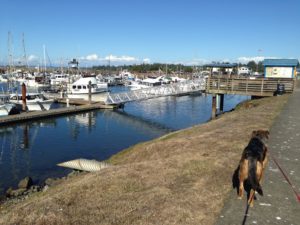
We are in Charleston, Oregon, a small fishing village situated along Coos Bay and the South Slough, forming the largest estuary on the Pacific Coast. Ocean access is just a quick drive from here, and right across the street is a short beach at the clamming mudflats where we take our family time walks at low tide.
The city of Coos Bay, the biggest town on the coast, is 20 minutes away with a Walmart, Safeway and Fred Meyer, but no Costco. So before we left Florence, we drove into Eugene, an hour and a half each way, to get dog food for the next 2 months. We also got haircuts at a recommended woman barber, the best we’ve had since our long-time hair stylist in Phoenix!
We’re in space #28 at the Charleston Marina and RV Park. It’s essentially a big parking lot with laundry, a rec room and a crab cleaning station, adjacent to the marina where private and commercial boats come in and out. We are backed into our double wide spot so there’s room for the car, our chairs and a picnic table outside our door. The space next to us is empty so it feels pretty roomy. Most of our neighbors are here to fish for salmon and tuna and crab, and they are gone much of the day.
We’ve been exploring our new neighborhood, driving the scenic road south for those spectacular ocean views, feasting on senior fish and chips at one of the dozen restaurants in this fishing town. We ate some really good falafel and gyros sandwiches in Coos Bay, and walked around a gorgeous city park with a lake.
And it is warmer here, mid 60’s to 70’s with good sun and less wind and fog, so it is easy to be outside.
This is my favorite place, hands down, from the inside out. I can’t really explain it yet, but it feels like home. Like Cayucos did. And I am so glad to be here for the entire month. There’s time to go to the Cranberry Festival next weekend and the Oregon Shorebird Festival the weekend after that.
And I finally ordered an inflatable kayak! I’ve been talking about it for more than a year, but with work so quiet it was hard to justify. But I know it will fill me and fuel me and be so good for me! I’ll start in the lakes so I don’t have to worry about the tides and boat traffic.
You might think that this life is all joy and happiness. But I’m not working. And I need to. Not just for the income, but for the engagement with others, for the feeling of helping others, and connecting with people on a deeper level.
So now that we’re in one place for a while with good wifi and cell service, I’m ready to work with clients, make some new Mac training videos, and do more of my real work in the world.
Perhaps you, too, are ready, to spark something in your life. Let’s set up a coaching call to fan your fire and ignite a flame. And if you’re a Mac user, check out the upcoming THE ORGANIZED MAC online class that begins September 19 at www.mac2shool.com/biz/
Happiness on the Oregon Coast
|
 We decided to stay three extra days to make up for the days we lost not being here sooner. We’re eating local Dungeness crab, fresh, off-the-boat halibut and salmon, clam chowder and oysters. And the Farmer’s Market is gorgeous and delicious, with peaches, peppers, sweet carrots and heirloom tomatoes. 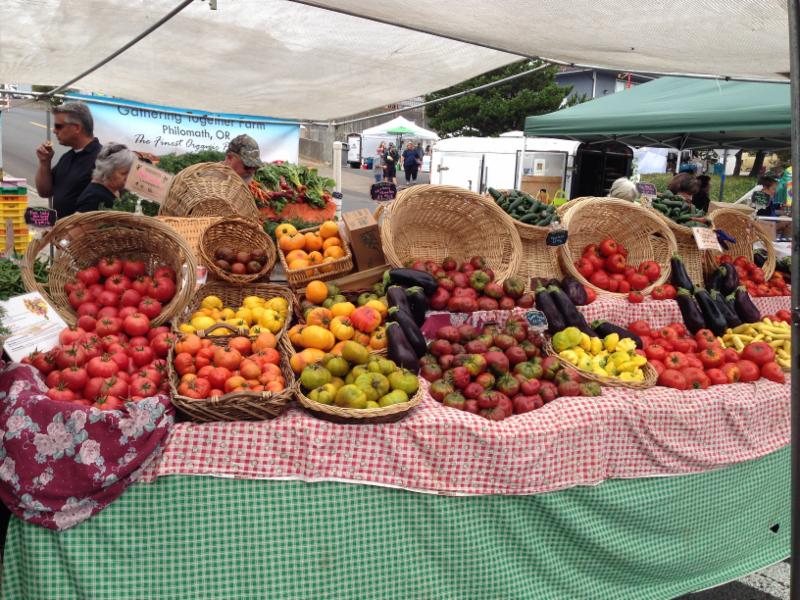 On Friday we went to the free “Shop the Dock” program at the commercial docks and learned about the different fisheries in the area and the difference between trolling, catching one fish at a time on a line, and trawling, using a large net to catch many fish. A halibut fisherman demonstrated how fast you have to work when reeling in a 40-foot fish by hand. 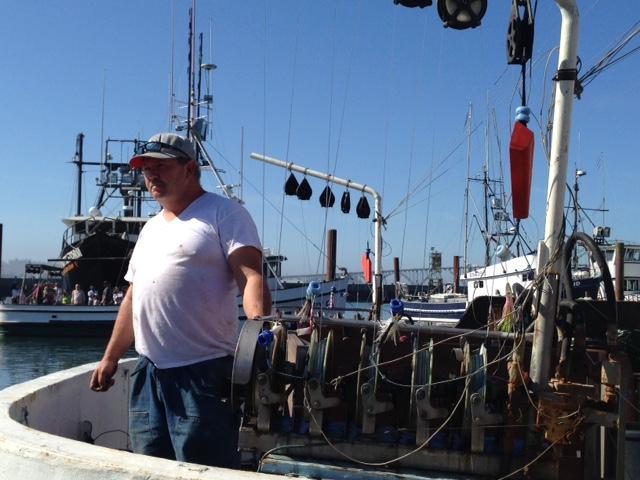 We went to the Lincoln County Fair and ate corn dogs, and we checked out the exhibits at the local art centers in Nye Beach. I paddled in a handmade kayak at the Wooden Boat Festival in Toledo, and we watched gray whales feed so close to the shore at the Headlands. 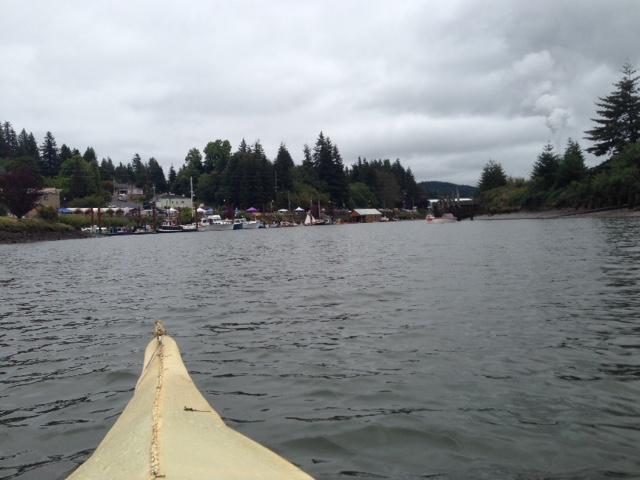 We’ve been walking the estuary trail along the back of Yaquina Bay, watching mostly gulls and cormorants bob in the water. I’m riding my bike along the paved bike paths, out to the jetty and around the marina, and remembering how much more I enjoy biking than walking.
And in the midst of all of this exploring and delighting, I enjoyed a one-on-one Mac phone session with a new client, hosted the last live Q&A phone call with my Organized Mac students, and facilitated the amazing Dream Altars workshop. It is this balance of working and playing that makes me most happy, that I’d like more of. Surprisingly, I haven’t yet spent any time at the ocean. The waves feel too big and loud, and it has been so darn windy. So I have been appreciating the gentleness and proximity of the bay, and the views from inside the motorhome.  We’ll be heading south to Florence and staying at the Port of Siuslaw for the rest of August, enjoying more seafood and fresh, local goodness, and seeing and experiencing whatever lies ahead. |
Welcome to the Oregon Coast!
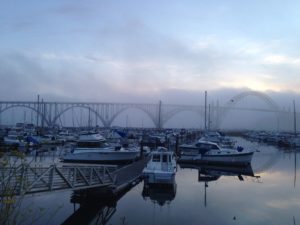
Last week we were still in Montana, awaiting a fix on a faulty tire sensor on our tow vehicle. We spent the night in the Walmart parking lot with a dozen other motor homers, and chatted with a young couple traveling across the country in an SUV, visiting every National Park.
On Wednesday at noon, we finally hitched the car and headed west. It was a long three days of driving, 789 miles through Idaho and Washington, and we finally pulled into the marina in Newport, Oregon on Friday after 5, tired and happy to have finally arrived.
We drove over to the seafood market for dinner to go, came home and prepared fresh Dungeness crab meat on a bed of romaine for me, the best clam chowder and smoked oysters for Marika, and a kid’s portion of local fish and chips with extra tartar sauce to share.
We spent the night in the dry camping area behind the marina buildings, across the bay from the active fishing port, then moved into our reserved spot in the main campground/parking lot on Saturday.
We restocked the pantry at the Farmer’s Market with peaches, blackberries, heirloom tomatoes, cucumbers, carrots, eggplant, sourdough bread and amazing almond pastries. Marika made crab cakes one night and a vegetable medley with chicken another.
On Monday, we moved again to the annex area for 4 nights, where the spaces are smaller and even closer together.
But it’s all about the location. We are at the marina, which is between the ocean and the bay, next to the Oregon Aquarium and Hatfield Marine Research Center, and the crabbing pier, the estuary, and the Yaquina Head Lighthouse. And we hear barking seals and screaming gulls and honking Canada geese, even with the windows closed.
And there are bike paths! I rode out to the jetty and around the day use area, the mist from the fog cooling my skin and the sea air filling my lungs so deeply that I felt them expanding in my back body. In the afternoon the fog hangs low and the wind picks up and the Yaquina Bridge fades in and out of view.
And it is again a balance of daily living and sightseeing, client calls and bike rides. Yesterday I taught the magical Dream Altars workshop at a studio in Yachats and I couldn’t help but reflect back to nineteen years ago when all of this was just a dream for me, for Marika, for us. I made a new altar, to spark the energies of my next big dream, which is all this, and so much more.
Between Here and There, I Surrender
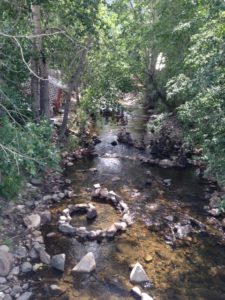
I am writing this on Monday morning from Basin, MT, where we are still waiting for the car to be ready. The wheel for the car DID arrive on Friday. But the tire pressure sensor got lost in the shipment, and they still need some clips, so they had to reorder the parts. Maybe they’ll show up today. Maybe the car will be done by the afternoon, or Tuesday. They reminded us that we’re in a rural part of the country, and things take a little longer to arrive.
I started to freak out that we’d be here another week and Marika suggested the word surrender. She assured me that we will get to the Oregon coast in time for my Dream Altars class next Tuesday. It’s a 4 day straight drive, which I’d rather do in 5 or 6. But we will get there.
Once I settled into the facts and let go of our original plan, I was actually glad we didn’t leave on Friday. We had the weekend to accept the not knowing, to ease into what we need to do to be ready to leave, pull out, get on the road. We did some serious housecleaning, sorted through the two remaining boxes and restocked the pantry and fridge.
And we had another day of exploring the area, this time to the well-known Archie Bray Foundation. Situated on land next to an abandoned brick making factory, the Foundation is a mecca for ceramic artists from all over the world to come and work. And the grounds are decorated with sculptures and pots and all kinds of ceramic artworks. We walked around the property, peered into the broken windows of the original brick factory. We walked inside one of the original kilns, a beehive structure with a twenty-foot ceiling, built exclusively with bricks. The afternoon light streamed in through the spaces in the bricks that had served as vents for the oven.
As we drove home in a slow rain storm, I realized that I also needed to start creating some forward-moving energy so I wouldn’t feel stuck, waiting. I needed to look ahead to being at the coast, even if I didn’t know WHEN we would get there, and to start feeling the excitement of being at the ocean. In Oregon. For three months. Big dreams coming true.
And maybe that scares me a little. To know that we are really doing it, just like I imagined we would seventeen years ago, when we spent six weeks on the Oregon coast, and I dreamed of this full-time life, staying at the marina, crabbing, birding, writing.
Because now what? Once we get to the coast, the only big dream left is the one I keep dragging my feet about, holding my breath against, putting off until someday. A part of me knows that my time on the coast will be all about embracing this next big dream, and taking the steps toward making it real.
Which may be why I started to think about cancelling the class to take all pressure off, and even changing our route to spend more time exploring Montana.
But Marika reminded me that I have students signed up, that we will get there in time, and so we are sticking to the original plan.
As much as I’ve loved being here in this place of healing and simpleness, I’m readying for the new shifts that are on the horizon, and all that is coming next. Even if it is so big and scary, because it is also big and wonderful. Like most dreams are.
